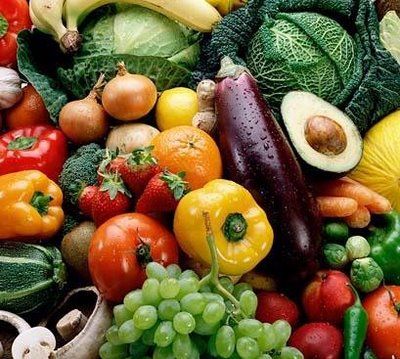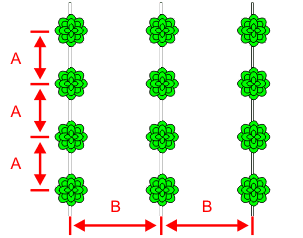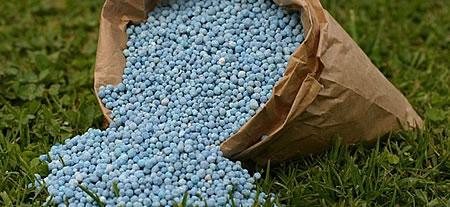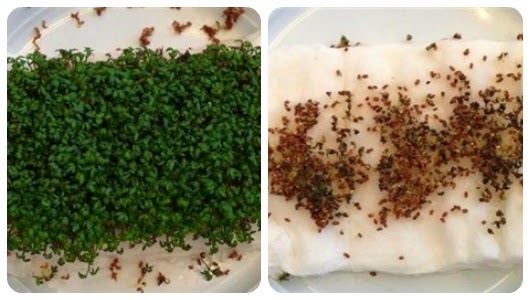Learn about the nutrients that plants need to be healthy and strong.
Whether growing in the garden or growing in pots, plants use minerals for their nutrition. Complex processes that contribute to the creation of minerals in soil include natural rock decay, decomposition of organic matter, animals and organisms, and microbial activity. Roots take up nutrients as ions dissolved in water. There are many parameters that affect the uptake of nutrients by plants. Ions may be readily available to plant roots, or they may be bound to other elements, or to the soil itself. Soils with high pH (alkaline) or low pH (acidic) result in mineral nutrients being unavailable to plants.
Fertility or Nutrition
The term ‘fertility’ refers to the natural ability of the soil to supply nutrients to plants in the necessary quantities and proportions. The term ‘nutrition’ refers to the interconnected steps by which a living organism assimilates food and uses it to grow. Previously, when referring to plant growth, we thought of soil fertility or how much fertilizer had to be added to increase the corresponding amounts of minerals. Most fertilizers were developed to address mineral deficiencies in the soil. The use of soil mixtures, intensive research on nutrient mixtures and in hydroponics, and developments in plant tissue analysis have led to a better understanding of the plant nutrition process. Plant nutrition is a term that takes into account the interdependence between mineral nutrients in soil or soil-free (hydroponics) cultures and their role in plant growth. This interdependence involves a complex balance of mineral nutrients that are essential and others that are beneficial for optimal plant growth.
Essential vs Beneficial elements
The term essential mineral element (or mineral nutrient) was proposed by Arnon and Stout in 1939. They concluded that three criteria must be met for an element to be considered essential. The criteria are:
- A plant will not be able to complete its life cycle if this nutrient is lacking.
- The function of the element must not be substitutable by another mineral element.
- The element must be directly related to the metabolism of the plant.
These criteria are basic guidelines, but exclude beneficial mineral elements.
Beneficial elements are those that can offset the toxic effects of other elements or can replace mineral nutrients in other less specific functions such as osmotic pressure.
The neglect of beneficial elements in commercial production and cultivation may mean that plants do not grow as much as they really can, but only to a level that ensures their maintenance. In this article, we will discuss both essential and beneficial elements for plants.
What are the mineral elements?
There are 20 mineral elements that are beneficial for plant growth.
Carbon (C), hydrogen (H) and oxygen (O) are provided by air and water. Plants need large quantities of the six macro-nutrients nitrogen (N), phosphorus (P), potassium (K), calcium (Ca), magnesium (Mg) and sulphur (S). The other nutrients (micro-nutrients) are needed in small quantities by plants. The micro-nutrients are: boron (B), chlorine (Cl), copper (Cu), iron (Fe), manganese (Mn), sodium (Na), zinc (Zn), molybdenum (Mo) and nickel (Ni). Beneficial minerals include silicon (Si) and cobalt (Co).
Beneficial elements may be useful only for certain plants and not for all plants. The distinction between essential and beneficial elements is often difficult for some of them. For example, cobalt is essential in legumes for nitrogen uptake. Cobalt can also inhibit ethylene formation (Samimy, 1978) and extend the life of cut roses (Venkatarayappa et al., 1980). Silicon, accumulated in cell walls, has been found to improve heat and drought resistance and increase resistance to insect and fungal attack. Silicon, acting as a beneficial element, can also help to offset toxic levels of manganese, iron, phosphorus, aluminium and zinc deficiency.
A more holistic approach to plant nutrition would not be limited to nutrients that are essential for survival, but would include mineral nutrients that are beneficial for optimal growth.
Mineral elements in plant production
Until 1960, the use of soil in greenhouses was common practice. Today, only a few producers still use soil. Most production is done with soil-free mixtures. Soil-free mixtures should provide plant support, aeration, nutrients and moisture retention, which is what soil does, but with a different addition of fertilisers and nutrients. Many soil mixes contain calcium, magnesium, phosphorus, sulphur, nitrogen, potassium and some micronutrients incorporated into them as fertiliser. However, nitrogen and potassium should be added during production. The difficulty in mixing the nutrients correctly and homogeneously can lead to uneven crop yields or even to toxic level concentrations in some places.
Soil mixtures that require the farmer’s additional addition of micro and macro nutrients in the form of liquid solutions provide better crop control to the farmer. To achieve optimum production, the farmer can adjust the nutrients to compensate for any effects of the environment. The uptake of mineral nutrient ions depends on a number of factors, including weather conditions. These parameters include cation exchange capacity (CEC), pH (see article on pH) and the total alkalinity of the water used for irrigation.
Total cation exchange capacity or CEC
The total cation exchange capacity refers to the ability of the growing medium to hold exchangeable minerals within its structure. Cations include ammonium nitrogen, potassium, calcium, calcium, magnesium, iron, manganese, zinc and copper. Sphagnum peat and mixtures containing tree bark, sawdust and other organic materials all have the same level of total cation exchange capacity.
pH. What does it mean?
Read the detailed article on soil pH.
Most crops, need the soil pH to be between 5.5 and 6.2, or in other words, slightly acidic. At these pH levels, maximum availability of essential nutrients to plants occurs. Fluctuations in pH, or higher or lower soil pH values, lead to inefficient absorption of nutrients or even toxicity.
The elements for complete plant nutrition
Here is a brief guide to the role of essential and beneficial mineral nutrients that are important for growth. Lack of some of these will result in abnormal plant growth, symptoms of deficiency or failure to reproduce.
Macronutrients
Nitrogen
Nitrogen is a major component of proteins, hormones, chlorophyll, vitamins, enzymes that are essential for plant life. Nitrogen metabolism is essential for the growth of stems and leaves (vegetable growth). Excessive nitrogen can retard the growth of flowers and fruits. Lack of nitrogen can reduce production, lead to yellowing of leaves and delay growth.
Sources of nitrogen for plants
Manure, urea (urine of healthy people), legumes mixed with soil before flowering (e.g. lentils, beans), compost, fertilisers (organic and inorganic)
Phosphorus
Phosphorus is essential for seed germination, photosynthesis, protein formation and almost everything to do with plant growth and metabolism. Phosphorus is essential for the formation of flowers and fruit. Low soil pH values (<4) result in phosphorus being trapped in the organic elements of the soil. Symptoms of phosphorus deficiency are purple color on stems and leaves, delayed maturity and growth. Fruit and flower crops are small. Premature fall of fruits and flowers. Phosphorus should be applied close to the roots of the plants so that the plant can use it. Large amounts of phosphorus without adequate levels of zinc can lead to zinc deficiency.
Sources of phosphorus for plants
Bone meal, fish meal, mineral phosphate, compost, manure.
Potassium
Potassium is essential for the formation of sugars, starches, carbohydrates, protein synthesis and cell division in roots and other parts of the plant. It helps adjust water balance, improves stem stiffness and cold hardiness, improves taste and color in fruits and vegetables, increases oil content in fruits, and is important for vegetables in which we eat the leaves. Potassium deficiency results in low production, curled leaves with spots, or leaves with a burnt appearance.
Sources of potassium for plants
Compost, wood ash, alfalfa meal, potassium chloride, potassium divine, granite powder
Sulphur
Sulphur is a building block of amino acids, proteins, vitamins and enzymes and is essential for the production of chlorophyll. It affects the taste in many vegetables. Sulphur deficiency is visible in the leaves, which become light green in colour. Sulphur is lost from the soil by leaching and should be added by the use of amendments. It is possible that the water used for irrigation may also contain sulphur and make up for the sulphur lost from the soil through leaching.
Sources of sulphur for plants
Gypsum, fertilisers containing the word ‘sulphate
Magnesium
Magnesium is a critical building block of the chlorophyll molecule and is essential for the function of plant enzymes to produce carbohydrates, sugars and fats. It is used to make fruits and nuts. It is essential for seed germination. Magnesium-deficient plants appear chlorotic, show yellowing between the veins of older leaves and may even have their leaves fall off. Magnesium is leached out by watering and should be added with conditioners. It can also be applied in the form of a spray directly on the leaves.
Sources of magnesium for plants
Sul-Po-Mag, calcareous limestone, dolomitic limestone, Epsom salt, water-soluble trace element mixtures
Calcium
Calcium activates enzymes, is a building block of the cell membrane, influences water movement in cells and is essential for cell growth and division. Some plants need calcium to absorb nitrogen and other minerals. Calcium is easily leached out during watering. Once calcium is deposited in plant tissue, it does not move, so there must be a constant supply of calcium for growth to occur. A lack of calcium leads to an interruption in the growth of stems, flowers and roots. Among the symptoms of calcium deficiency are reduced growth, black spots on leaves and fruits. Yellowing of the leaf tips may also occur.
Sources of calcium for plants
Gypsum, soft-rock phosphate (colloidal phosphate), limestone, Epsom salts
Micronutrients
Iron
Iron is essential for many of the functions of enzymes and acts as a catalyst for the synthesis of chlorophyll. It is essential for the young growing parts of plants. Symptoms of iron deficiency are pale young leaves that subsequently turn yellow. Iron is leached from the soil by watering and is retained in the lower layers of the soil. If the soil pH is high (alkaline soil), then iron cannot be absorbed by plants. In alkaline soils there may be an abundance of iron, but it may not be absorbed by plants. Applying an acidic conditioner containing chelated iron can correct the problem.
Sources of iron for plants
Iron chelate, iron sulphate, iron oxides, water-soluble mixtures of trace elements
Manganese
Manganese is involved in the activity of enzymes for photosynthesis, respiration and nitrogen metabolism. Manganese deficiency can result in the appearance in young leaves of a network of green veins on a light green background. This symptom is similar to iron deficiency. In advanced stages of manganese deficiency, the light-coloured parts of the plant turn white and the leaves fall off. Brown, black or grey spots may appear next to the veins. In neutral or alkaline soils, plants often show symptoms of manganese deficiency. In acidic soils, manganese may be present in such a concentration that it becomes toxic to plants.
Sources of manganese for plants
Water-soluble trace element mixtures
Boron
Boron is essential for cell membrane formation, membrane integrity, calcium absorption and can help in the circulation of sugars. Boron affects at least 16 functions in plants. These functions include flowering, pollen germination, fruit production, cell division, hormone movement and water circulation. Boron must be available throughout the life of the plant. It is not translocated and is easily leached from soils. Boron deficiency kills the terminal buds. The leaves are thick, curved and brittle. Fruits, tubers and roots lose their colour, show cracks and are speckled with brown spots.
Sources of boron for plants
Water-soluble mixtures of trace elements, borax, boric acid, sodium borate, sodium tetraborate, liquid boron
Zinc
Zinc is a component of enzymes or a functional cofactor of a large number of enzymes including growth hormones (plant growth hormones). Zinc is important for carbohydrate metabolism, protein synthesis and inter-genital elongation (stem development). Zinc-deficient plants have spotted leaves with unevenly chlorotic areas. Zinc deficiency, leads to iron deficiency so the plants show the symptoms of iron deficiency. Zinc deficiency occurs in eroded soils and is less available at pH values of 5.5 to 7.0. Lowering the pH makes zinc more available, to the extent that it can become toxic to the plant.
Sources of zinc for plants
Water-soluble trace element mixtures, algal meals
Copper
Copper is concentrated in the roots of plants and plays a role in nitrogen metabolism. It is a component of various enzymes and may be part of enzyme systems that use carbohydrates and proteins. Copper deficiency results in the death of young limbs and the development of brown spots on terminal leaves. Copper binds strongly to organic matter and can be deficient even in soils rich in organic matter. It is difficult to lose from the soil, but often it may simply be unavailable. Copper in large proportions can be toxic.
Sources of copper for plants
Water-soluble trace element mixtures, copper sulphate
Molybdenum
Molybdenum is a structural component of enzymes that reduce nitrate to ammonia. Without molybdenum, protein synthesis is blocked and plant growth stops. Root tuber bacteria (nitrogen-fixing bacteria – nitrogen-fixing bacteria) also need molybdenum. If there is a molybdenum deficiency the seed may not fully develop and nitrogen deficiency may occur. Symptoms of molybdenum deficiency are pale leaves with limbs that turn inward.
Sources of molybdenum for plants
Water-soluble trace element mixtures, compost
Chlorine
Chlorine is involved in osmosis (the movement of water or solutes into cells), the ionic balance necessary for plants to obtain nutrient minerals, and photosynthesis. Symptoms of chlorine deficiency include wilting, stubby roots, chlorosis and bruising. Odors in some plants may be reduced. Chloride, the ionic form of chlorine used by plants, is usually found in soluble forms and is lost by leaching. If chlorine levels are high, some plants may show signs of toxicity.
Sources of chlorine for plants
Compost, city water that is chlorinated
Nickel
Nickel recently gained designation as an essential element for plants, according to the Agricultural Research Service Plant, Soil and Nutrition Laboratory in Ithaca, N.Y. (http://www.ars.usda.gov/main/site_main.htm?modecode=19-07-05-05). It is needed for the enzyme urease to break down urea and release nitrogen in a usable form for plants. Nickel is also needed for iron absorption. Seeds need nickel to germinate. Plants that grow without extra nickel will show symptoms of deficiency when they reach the stage of maturity and fruit production. If there is a nickel deficiency, plants will not produce seeds that are viable.
Sources of nickel for plants
I have not found anything relevant
Sodium
Sodium is involved in osmotic (fluid movement) and ionic balance in plants.
Sources of sodium for plants
Compost, manure
Cobalt
Cobalt is needed in nitrogen fixation in legumes and in root nodules of non-legume plants. The need for cobalt is greater for nitrogen fixation than for ammonium nutrition. Cobalt deficiency leads to sodium deficiency and displays the symptoms of sodium deficiency.
Silicon
Silicon is found as a component of cell membranes. Plants that have access to soluble silicon produce stronger and more resilient cell membranes, creating a natural shield in plants that are more resistant to mycelial insects. It also increases the plant’s resistance to heat and drought. Spraying the leaves with silica has also proved beneficial as it reduced the aphid population. Tests also showed that silicon is deposited by plants at the sites of a fungal infection to fight the penetration of cell membranes by the attacking fungus. Positive effects of silicon on plants include strengthening of stems and prevention or suppression of iron or manganese toxicity. Silicon, not classified as an essential element for plants, but may be beneficial to many of them.
Sources
WHAT IS PLANT NUTRITION?
Plant nutrition – Wikipedia, the free encyclopedia
Tags: BORON • CALCIUM • CHLORINE • COBALT • COPPER • ELEMENTS • IRON • MAGNESIUM • MANGANESE • MOLYBDENUM • NICKEL • NITROGEN • NUTRITIOUS • PHOSPHORUS • PLANTS • POTASSIUM • SILICON • SODIUM • SULFUR • TRACE ELEMENTS • ZINC





